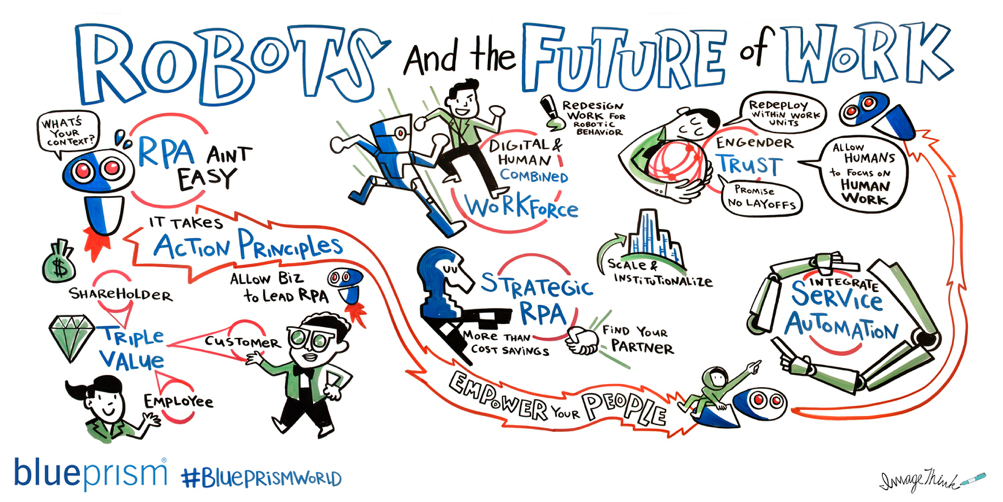
Key take-aways from Blue Prism World 2017
The Blue Prism Partner World- events gathered over 1500 people to New York and London in June 2017 to hear the latest news from Blue Prism and visionary industry keynotes, and customers sharing their RPA experiences. Digital Workforce joined the buzzing seminar on both continents.
The recently launched Digital Workforce Academy peaked visitors’ interest as it offered the only e-learning platform focusing on more than just one specific technology. In addition, the ability to receive login details to the online learning portal to anywhere in the world within a few days of filling in the order form attracted positive attention. Other discussions evolved around the issue of moving forward from doing mere pilot and proof of concept automation projects. Especially those who had been involved with RPA projects already understood the importance of creating RPA capabilities within an organization, which goes way beyond the technical requirements. Everyone shared the same sentiment – RPA needs to be utilized strategically.
Key take-aways from 7.6. New York- event
Jon Theuerkauf, BNY Mellon (Bank of New York): Run fast and allow failure

“The existing environment today is at least 3-5 years out from a fully integrated automated operating environment leading the way to AI. Begin your automation efforts with the end in mind, and remain focused on a more structured operating environment”, Jon Theuerkauf.
DO! – The beginning and continuing of investing in RPA technologies is the DOING part of automation.
THINK! – Maturing into a Machine Learning and AI enabled world is the THINKING part of automation.
The future will land somewhere between ro-topia and ro-pocalypse. What are the implications?
- Managers and workers can ’code’ and are managing work by exception management and client interactions
- Machines and AI WILL NOT require structured data or structured processes
- SmartBots and people will work side by side through the transition period, and slowly bots will phase in more and more
- Customers and regulators will demand increasing speed and accuracy only achieved through automation
- There will be exchangeable automation utilities available across platforms and organizations
Professor Mary Lacity, UMSL (University of Missouri-St. Louis): RPA is strategic!

“Consider RPA for more than cost savings or you will miss value”, Mary Lacity.
The evolution of RPA
Phase 1: Identifying the “want” for RPA
Phase 2: Focus primarily on cost savings (POCs, pilots, practices)
Phase 3: Focus on the triple-win, enact action principles
Phase 4: In the future, RPA will be institutionalized in every organization and integrated with other innovations. We are not there yet!
What are organizations actually doing with FTE savings generated from service automation?
- Redeploy people (49%) within unit and outside unit (32%)
- Reduce FTE’s from provider (32%)
- Take on more work 26%
- Only 13 % lay off employees!! It is not zero, but not the 47%!
Key opportunity – Talk about hours back to business!
Redesign human work for robotic by considering:
Nature of work
- From high-level instructions to defining explicit instructions
- From mixing rules and judgmental tasks to re-sequence of tasks
Access & Identify
- Two-three factor authentication, password resets, employee numbers, DOB to Logon ID and passwords for each software robots
Security
- Designed for human behavior: Example Idle- times -> screen locks. Robots have different requirements!
Key take-aways from 21.6. event in London
Brian Halpin, HSBC: Keep calm it’s not rocket science!
“20% of total effort constitutes for 80% of total results!”, Brian Halpin.
You shouldn’t try to automate everything at once. Always automate the simple parts of the process first. Pick the low hanging fruits first and move forward from there!
Rules of success:
- Keep it simple (80/20) and seek opportunities to replicate, extend or re-use.
- Optimize processes first for automation.
- Consider all options when reviewing a process for RPA – Find the most fitting tool!
- Be very clear how you will measure and realize benefits (before you start!).
- Significant value exists in processes that are perceived to require human ‘judgement’ – Challenge the need for ‘judgement’!
- Develop a ‘Centre of Excellence’ and federate with care.
- A global ‘command center’ can support monitoring, execution & capacity management.
- Recognize that you are creating a new operational capability not just doing projects!
- Continuous improvement based on data and process knowledge can be your best source of opportunity.
22.6. Round-table with Professor Leslie Willcocks, LSE (London school of economics): Make automation strategic from beginning
“When messaging change to staff communicate often!”, Leslie Willcocks.
Three enablers of RPA
1. Shareholder value
2. Customer value
3. Employee value
Risks
- Tool selection –> wrong/bad tool
- Stakeholder buy-in –> stall/derail project
- Operational/execution –> robots not functional
- Change Management –> HR/cultural misfits
- Strategy –> thinking small/short term
- Others
Leslie’s favorite quote: “You have to plan where this is going, not where it is now. You have to build a foundation for a tower block, not a bungalow.” – Patrick Geary, Blue Prism